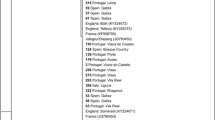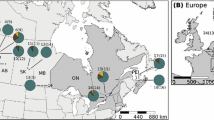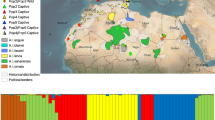Abstract
The German wasp (Vespula germanica) is a highly successful invader on a global scale. These wasps were first observed in the Western Cape region in South Africa in 1972, and they have the potential to expand their range and cause significant damage to the native biodiversity. Our study used nuclear (DNA microsatellites) and mitochondrial DNA (mtDNA) from 42 wasp colonies to analyse the population genetics of V. germanica in their invaded South African range. We sequenced three mitochondrial genes; cytochrome c oxidase I, cytochrome b and cytochrome c oxidase II. We found six mtDNA haplotypes present in South Africa. Although only a single fertilized queen is sufficient for the establishment of a wasp nest, the probability of a single introduced queen to successfully establish a nest and a population is very small. If multiple queens were introduced at the same time, the probability for more than one haplotype being transferred to the new population increases. Therefore, the true number of queen introductions occurred in South Africa can be inferred to be between two and six. We examined nine microsatellite loci and found weak-to-no genetic sub-structuring, likely due to high dispersal rates. We concluded that German wasps in South Africa maintain a homogenous population with movement of individuals between localities.






Similar content being viewed by others
References
Abdelkrim J, Pascal M, Calmet C, Samadi S (2005) Importance of assessing population genetic structure before eradication of invasive species: examples from insular Norway rat populations. Conserv Biol 19:1509–1518
Arca M, Capdevielle-Dulac C, Villemant C et al (2012) Development of microsatellite markers for the yellow-legged Asian hornet, Vespa velutina, a major threat for European bees. Conserv Genet Resour 4:283. https://doi.org/10.1007/s12686-011-9525-1
Archer ME (1998) The world distribution of the Euro-Asian species of Paravespula (Hym., Vespinae). Entomol Mon Mag 134:279–284
Azzurro E, Golani D, Bucciarelli G, Bernardi G (2006) Genetics of the early stages of invasion of the Lessepsian rabbitfish Siganus luridus. J Exp Mar Biol Ecol 333:190–201
Bandelt H-J, Forster P, Röhl A (1999) Median-joining networks for inferring intraspecific phylogenies. Mol Biol Evol 16:37–48
Beggs JR, Brockerhoff EG, Corley JC et al (2011) Ecological effects and management of invasive alien Vespidae. Biocontrol 56:505–526
Belkhir K, Borsa P, Chikhi L, et al (1998) GENETIX 4.05, logiciel sous Windows TM pour la génétique des populations. Laboratoire Génome, Populations, Interactions, CNRS UMR 5171, Université de Montpellier II, Montpellier, France
Beye M, Hasselmann M, Fondrk MK, Page RE, Omholt SW (2003) The gene csd is the primary signal for sexual development in the honeybee and encodes an SR-type protein. Cell 114:419–429
Bonckaert W, Vuerinckx K, Billen J, Hammond RL, Keller L, Wenseleers T (2008) Worker policing in the German wasp Vespula germanica. Behav Ecol 19:272–278
Brenton-Rule EC, Dobelmann J, Baty JW et al (2018) The origins of global invasions of the German wasp (Vespula germanica) and its infection with four honey bee viruses. Biol Invasions 20:3445–3460
Chapman RE, Bourke AFG (2001) The influence of sociality on the conservation biology of social insects. Ecol Lett 4:650–662
Crozier RH, Page RE (1985) On being the right size: male contributions and multiple mating in social Hymenoptera. Behav Ecol Sociobiol 18:105–115
D’adamo P, Sackmann P, Corley JC, Rabinovich M (2002) The potential distribution of German wasps (Vespula germanica) in Argentina. N Z J Zool 29:79–85
Daly D, Archer ME, Watts PC et al (2002) Polymorphic microsatellite loci for eusocial wasps (Hymenoptera: Vespidae). Mol Ecol Notes 2:273–275
de Villiers M, Kriticos DJ, Veldtman R (2017) Including irrigation in niche modelling of the invasive wasp Vespula germanica (Fabricius) improves model fit to predict potential for further spread. PLoS ONE 12:e0181397. https://doi.org/10.1371/journal.pone.0181397
Dearden PK, Gemmell NJ, Mercier OR et al (2018) The potential for the use of gene drives for pest control in New Zealand: a perspective. J R Soc N Z 48:225–244
Ding G, Xu H, Oldroyd BP, Gloag RS (2017) Extreme polyandry aids the establishment of invasive populations of a social insect. Heredity 119:381–387
Dlugosch KM, Parker IM (2008) Founding events in species invasions: genetic variation, adaptive evolution, and the role of multiple introductions. Mol Ecol 17:431–449
Dobelmann J, Loope KJ, Wilson-Rankin E et al (2017) Fitness in invasive social wasps: the role of variation in viral load, immune response and paternity in predicting nest size and reproductive output. Oikos 126:1208–1218
Earl DA, vonHoldt BM (2012) STRUCTURE HARVESTER: a website and program for visualizing STRUCTURE output and implementing the Evanno method. Conserv Genet Resour 4:359–361
Ellstrand NC, Elam DR (1993) Population genetic consequences of small population size: implications for plant conservation. Ann Rev Ecol Syst 24:217–242
Estoup A, Guillemaud T (2010) Reconstructing routes of invasion using genetic data: why, how and so what? Mol Ecol 19:4113–4130
Evanno G, Regnaut S, Goudet J (2005) Detecting the number of clusters of individuals using the software STRUCTURE: a simulation study. Mol Ecol 14:2611–2620
Foster KR, Ratnieks FLW, Gyllenstrand N, Thorén PA (2001) Colony kin structure and male production in Dolichovespula wasps. Mol Ecol 10:1003–1010
Giliomee JH (2011) Recent establishment of many alien insects in South Africa: a cause for concern. Afr Entomol 19:151–155
Gloag R, Ding G, Christie JR et al (2017) An invasive social insect overcomes genetic load at the sex locus. Nat Ecol Evol 1:0011. https://doi.org/10.1038/s41559-016-0011
Goodisman MAD, Matthews RW, Crozier RH (2001) Hierarchical genetic structure of the introduced wasp Vespula germanica in Australia. Mol Ecol 10:1423–1432
Goodisman MA, Matthews RW, Crozier RH (2002) Mating and reproduction in the wasp Vespula germanica. Behav Ecol Sociobiol 51:497–502
Hasegawa E, Takahashi J (2002) Microsatellite loci for genetic research in the hornet Vespa mandarinia and related species. Mol Ecol Notes 2:306–308
Hasegawa M, Kishino H, Yano T (1985) Dating of the human-ape splitting by a molecular clock of mitochondrial DNA. J Mol Evol 22:160–174
Haupt K (2015) Assessment of the invasive wasp Vespula germanica in South Africa. M.Sc. Thesis. University of Stellenbosch
Huelsenbeck JP, Ronquist F (2001) MRBAYES: bayesian inference of phylogenetic trees. Bioinformatics 17:754–755
Johansson H, Seppa P et al (2018) Weak population structure in the ant Formica fusca. PeerJ 6:e5024. https://doi.org/10.7717/peerj.5024
Kearse M, Moir R, Wilson A et al (2012) Geneious basic: an integrated and extendable desktop software platform for the organization and analysis of sequence data. Bioinformatics 28:1647–1649. https://doi.org/10.1093/bioinformatics/bts199
Keller L, Reeve HK (1994) Genetic variability, queen number, and polyandry in social Hymenoptera. Evol (N Y) 48:694–704
Kenis M, Auger-Rozenberg M-A, Roques A et al (2009) Ecological effects of invasive alien insects. Biol Invasions 11:21–45
Kumar S, Stecher G, Tamura K (2016) MEGA7: molecular evolutionary genetics analysis version 7.0 for bigger datasets. Mol Biol Evol 33:1870–1874
Lester PJ, Beggs JR (2019) Invasion success and management strategies for social Vespula wasps. Annu Rev Entomol 64:51–71
Lester PJ, Gruber MAM, Brenton-Rule EC et al (2014) Determining the origin of invasions and demonstrating a lack of enemy release from microsporidian pathogens in common wasps (Vespula vulgaris). Divers Distrib 20:964–974
Loope KJ, Chien C, Juhl M (2014) Colony size is linked to paternity frequency and paternity skew in yellowjacket wasps and hornets. BMC Evol Biol 14:277. https://doi.org/10.1186/s12862-014-0277-x
Lowe S, Browne M, Boudjelas S, De Poorter M (2004) 100 of the World’s Worst Invasive Alien Species: a selection from the Global Invasive Species Database. Invasive Species. Published by The Invasive Species Specialist Group (ISSG) a specialist group of the Species Survival Commission (SSC) of the World Conservation Union (IUCN)
Markert JA, Champlin DM, Gutjahr-Gobell R et al (2010) Population genetic diversity and fitness in multiple environments. BMC Evol Biol 10:205. https://doi.org/10.1186/1471-2148-10-205
Marsden CD, Ortega-Del Vecchyo D, O’Brien DP et al (2016) Bottlenecks and selective sweeps during domestication have increased deleterious genetic variation in dogs. Proc Natl Acad Sci USA 113:152–157
Masciocchi M, Corley J (2013) Distribution, dispersal and spread of the invasive social wasp (Vespula germanica) in Argentina. Austral Ecol 38:162–168
Moller H (1996) Lessons for invasion theory from social insects. Biol Conserv 78:125–142
Myers N, Mittermeier RA, Mittermeier CG et al (2000) Biodiversity hotspots for conservation priorities. Nature 403:853–858
Nieminen M, Singer MC, Fortelius W et al (2001) Experimental confirmation that inbreeding depression increases extinction risk in butterfly populations. Am Nat 157:237–244
Oksanen J, Blanchet G, Kindt R, Legendre P, Minchin PR, O'Hara RB, Simpson GL, Solymos PM, Stevens HH, Wagner H (2019) vegan: Community Ecology Package. R package version 2.3–5. http://CRAN.R-project.org/package=vegan
Passera L (1994) Characteristics of tramp species. In: Williams DF (ed) Exotic ants: biology, impact and control of introduced species. Westview Press, Oxford, pp 23–43
Peakall R, Smouse PE (2012) GenAlEx 6.5: genetic analysis in Excel. Population genetic software for teaching and research—an update. Bioinformatics 28:2537–2539
Pimentel D, Zuniga R, Morrison D (2005) Update on the environmental and economic costs associated with alien-invasive species in the United States. Ecol Econ 52:273–288
Pritchard JK, Stephens M, Donnelly P (2000) Inference of population structure using multilocus genotype data. Genetics 155:945–959
Pyšek P, Richardson DM (2010) Invasive species, environmental change and management, and health. Annu Rev Environ Resour 35:25–55
Richardson DM, Macdonald IAW, Forsyth GG (1989) Reductions in plant species richness under stands of alien trees and shrubs in the Fynbos biome. South Afr For J 149:1–8
Rousset F (2008) genepop’007: a complete re-implementation of the genepop software for Windows and Linux. Mol Ecol Resour 8:103–106
Sackmann P, Rabinovich M, Corley JC (2001) Successful removal of German yellowjackets (Hymenoptera: Vespidae) by toxic baiting. J Econ Entomol 94:811–816
Sakai AK, Allendorf FW, Holt JS et al (2001) The population biology of invasive species. Annu Rev Ecol Syst 32:305–332
Schmack JM, Brenton-Rule EC, Veldtman R et al (2019) Lack of genetic structuring, low effective population sizes and major bottlenecks characterise common and German wasps in New Zealand. Biol Invasions 21:3185–3201
Spradbery JP, Maywald GF (1992) The distribution of the European or German wasp, Vespula germanica (F.) (Hymenoptera: Vespidae), in Australia: past, present and future. Aust J Zool 40:495–510
Sutton JT, Robertson BC, Jamieson IG (2011) Dye shift: a neglected source of genotyping error in molecular ecology. Mol Ecol Resour 11:514–520
Thomas CR (1960) The European wasp (Vespula germanica Fab.) in New Zealand. DSIR Information Series No. 27
Thompson JD, Higgins DG, Gibson TJ (1994) CLUSTAL W: improving the sensitivity of progressive multiple sequence alignment through sequence weighting, position-specific gap penalties and weight matrix choice. Nucleic Acids Res 22:4673–4680
Thorén PA, Paxton RJ, Estoup A (1995) Unusually high frequency of (CT)n and (GT)n microsatellite loci in a yellowjacket wasp, Vespula rufa (L.) (Hymenoptera: Vespidae). Insect Mol Biol 4:141–148
Tsutsui ND, Suarez AV, Holway DA, Case TJ (2000) Reduced genetic variation and the success of an invasive species. Proc Natl Acad Sci USA 97:5948–5953
van Oosterhout C, Hutchinson WF, Wills DPM, Shipley P (2004) Micro-checker: software for identifying and correcting genotyping errors in microsatellite data. Mol Ecol Notes 4:535–538
van Wilgen BW, De Lange WJ (2011) The costs and benefits of biological control of invasive alien plants in South Africa. Afr Entomol 19:504–514
Vandewoestijne S, Schtickzelle N, Baguette M (2008) Positive correlation between genetic diversity and fitness in a large, well-connected metapopulation. BMC Biol 6:46. https://doi.org/10.1186/1741-7007-6-46
Veldtman R, Addison P, Tribe GD (2012) Current status and potential future impact of invasive vespid wasps (Vespula germanica and Polistes dominulus) in South Africa. IOBC/WPRS Bull 75:217–227
Whitehead VB, Prins AJ (1975) The European wasp, Vespula germanica (F.), in the Cape Peninsula. J Entomol Soc South Afr 38:39–42
Wilson EO, Hölldobler B (2005) Eusociality: origin and consequences. Proc Natl Acad Sci USA 102:13367–13371
Acknowledgements
This work was funded by Victoria University of Wellington. We thank Julia Schmack for sharing her DNA microsatellite data with us and two anonymous reviewers for their useful comments that improved our original manuscript.
Author information
Authors and Affiliations
Corresponding author
Electronic supplementary material
Below is the link to the electronic supplementary material.
Rights and permissions
About this article
Cite this article
Eloff, J., Veldtman, R., Bulgarella, M. et al. Population genetics of the invasive wasp Vespula germanica in South Africa. Insect. Soc. 67, 229–238 (2020). https://doi.org/10.1007/s00040-020-00752-x
Received:
Revised:
Accepted:
Published:
Issue Date:
DOI: https://doi.org/10.1007/s00040-020-00752-x




